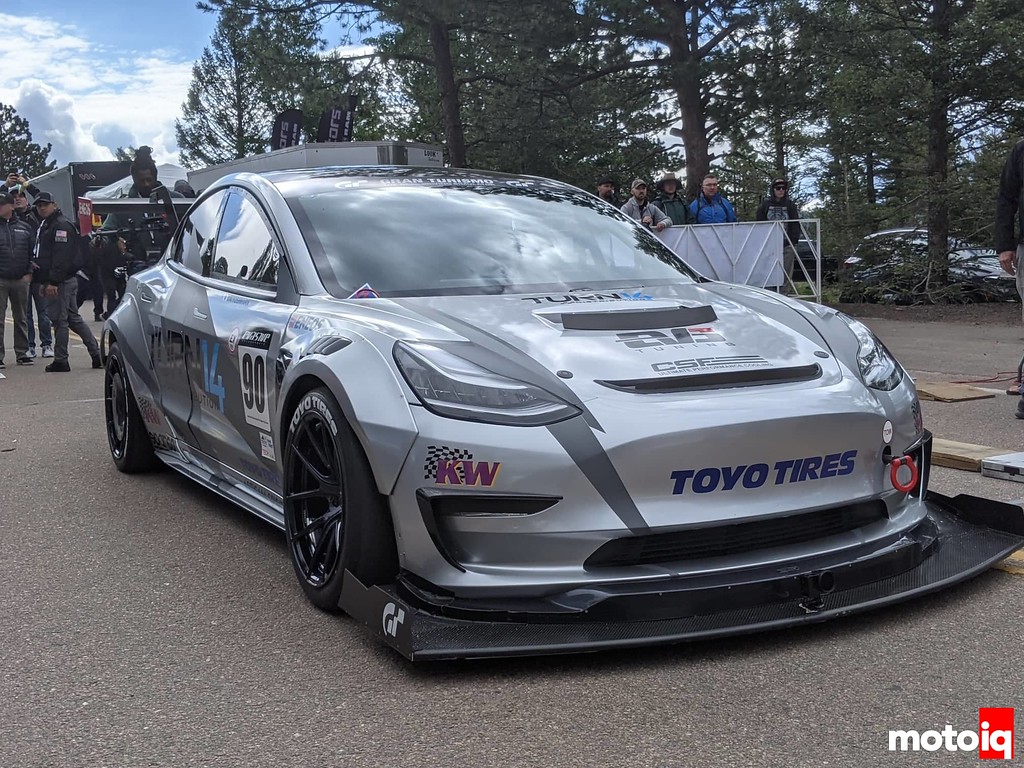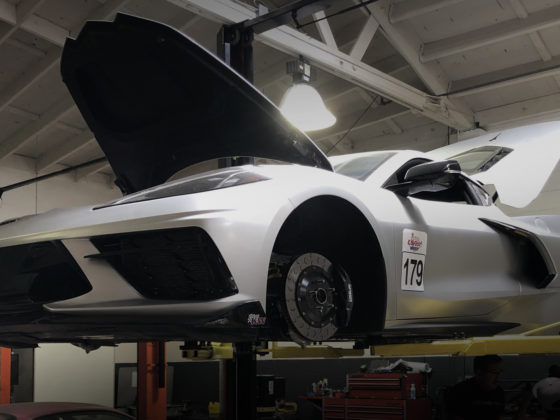
Like it or not, the electric revolution is coming. Electric cars already outpower IC-driven ones in contests of acceleration and as battery technology and battery management improves, it’s only a matter of time before the IC engine becomes an antique. Evasive Motorsports is already pushing the boundaries with their latest Pikes Peak/Time attack machine and it recently competed in the iconic event. As before, 2020 Unlimited Class Winner, Dai Yoshihara drove the Evasive Tesla Model 3 to the summit, and we went along as support for the chassis setup.
The story of this year’s event took a sad twist which we will talk about later, but first let’s take a look at just what is inside this revolutionary car.

The inclusive full cage was built by Chris Eimer of Eimer Engineering and it is pretty stout to be able to stand up to the violent crashes Pikes Peak can generate.

The cage was sort of difficult to make because the Tesla unibody uses a combination of welded steel and bonded aluminum stampings. The Tesla unibody is already pretty strong and the cage just makes it stronger and stiffer.

The car makes extensive use of carbon fiber to reduce weight. Evasive was able to remove about 900 lbs from the car and the cage added about 140 lbs back in. The carbon roof takes the place of the factory glass roof and removes in seconds for maintenance and access to the inside of the car. The doors and trunk are carbon as well.

A Motec C126 handles critical driver display and data logging. Data logging is critical to try to figure out how the batteries are being managed.




17 comments
Was the upright ground for clearance? Or clearanced by the wheel?
It’s just a mark that was on it.
Grinding on castings is common from suppliers to remove casting blemishes.
I am keen to see how fast this vehicle would go at World Time Attack with Dai driving. Any rough estimates Mike?
We have run BUttonwillow CW13 at 1:50 and we are going to do more development.
That’s fantastic Mike, within 12 seconds of the PZ Tuning Civic unlimited record. I assume that would be equivalent to a low 1:40min time at WTAC in ideal conditions.
The car’s potential is a couple of seconds faster.
They’re the future, they’re faster and better. I’ll still be an old dinosaur clutching to my ice powered vehicles thankyouverymuch.
Ok, I swear you posted about this before the race and THEN removed and now this is a revised look? Very cool insight! Bummer they never figured out the speed limiting. I was wondering, and a lot of these look like the Instagram photos I was following that weekend, why the aero discs were used sometime?? Ones like these on the Model 3 are sick and I think it’d be cool to run some if they benefit more than just the aesthetic.
FTR: I broke down and bought a used Model X for my run around this year, fastest car I’ve ever owned! Faster than my Scat Pack Challenger AND I’ve been too afraid to use Ludicrous Plus outside of a track setting. SOOO fast!
It got turned on early by mistake before I could get event pictures and then something happened to my camera so it’s low res small format. I was mad but posted anyway and sorry for the small low-quality pics. The aero discs are always on the car when it runs and only on the rear. It’s because they are prototypes and Evasive only had time to make 2 of them. The design is being revised to make them easier to take on and off and they will be available for sale sooner or later. The speed limiting isn’t a problem, the car is very fast till about 100 mph, at Pikes Peak we encountered a weird CANBUS error that caused the car not to boot up correctly which limited the power to 50 KW. The car has not done that before or since. It went on to break the electric car record at Buttonwillow which has since been broken again by Unplugged Performance in their Plaid. We are going to do more electronic work and come back. We have 440 hp vs 1100 hp but if we can tap into it all at our control, we can go faster than we did before. If we can’t beat the Plaid we can perhaps be the fastest Model 3!
What time was your run? Batteries could have been too cold.
If you continue to run in those conditions, maybe you could build extra thermal management like a coolant preheater similar to coolant based oil filter type oil coolers.
There is no such thing as too cold batteries in anything except drag racing. We try to let the batteries cold soak before we run after charging to give us a few more seconds of max power before derating.
Watch for the Snowflake Icon
“A blue snowflake icon may appear on your touchscreen if your car battery is too cold to access all of its stored energy. When this icon is displayed you may also notice that battery power and regenerative braking are limited. Once the battery is warmed, the snowflake will disappear.”
“ For example, AAA’s testers determined that the Tesla’s range when fully charged at 75 degrees was 239 miles, but it fell 91 miles, or 38%, at 20 degrees.”
“ “Ions are traveling inside of the battery between the positive and negative electrodes through a liquid electrolyte. As it gets colder, the liquid becomes thicker, now closer to freezing solid. So the ions move more slowly, which causes more resistance. The more the resistance goes up, the faster you lose power,” says Greg Less, Ph.D. He’s the technical director at the UM Battery Lab in Ann Arbor, Michigan. ”
I have to somewhat disagree here. For Lithium ion batteries you can be too cold. There is a specific operating range that the batteries like to be in. The oem tesla thermal system will actually intentionally run motors and adjust the thermal system to create waste heat when the batteries are too cold. If you ever have a chance to read it, the Tesla patent on their thermal system control is quite fascinating.
of course, that is obvious but when you are racing one of these cars, you need as much time thermal headspace as you can before the system starts to derate the motor to spare the battery. Preheating would make the car faster for the first minute or so but derating would start a couple of minutes later or less. For pikes peak you need to run something less than 11 minutes, we see derating after just two laps at Buttonwillow for instance. If we preheated the battery, the system would start to derate by the time the tires come up to temperature! Race one of these cars and see. We are working on a stand-alone control so we can control some of this stuff.
Ah, interesting. The thermal control project sounds very interesting. Probably one of the big gain areas of EV racing for sure. Will be interesting to see what you guys end up doing.
I don’t know why I meet soooo many people who absolutely refuse to think of the performance potential of plug-in hybrids. It’s baffling that even the younger generation (local to me at least) are so opposed to it. A model 3 is on my short list of cars I want in the future.